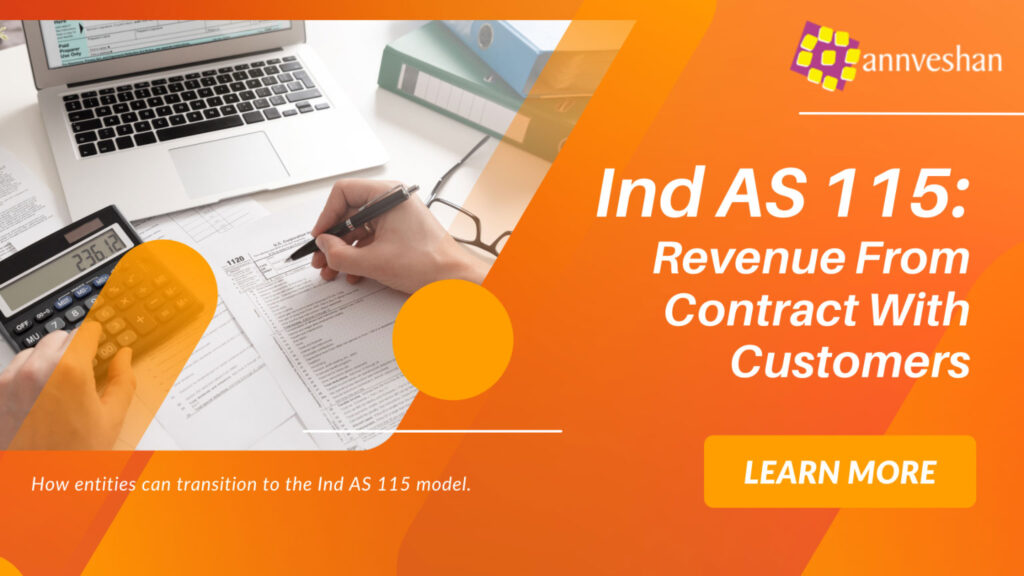Ind AS 115 – Revenue From Contract With Customers
According to the Ministry Of Corporate Affairs “The objective of Ind AS 115 is to establish the principles that an entity shall apply to report useful information to users of financial statements about the nature, amount, timing, and uncertainty of revenue and cash flows arising from a contract with a customer.”
Transitioning to a new revenue standard is likely to have a significant impact not only on accounting but also on the company’s data, system, and processes. The differences will significantly impact the changes in the identification of performance obligations, time of revenue recognition, measurement of the transaction price, and disclosures.
The 5 Step Model Of Ind AS 115
The core principle of the Ind AS 115 is that an entity shall recognize the revenue to depict the transfer of promised goods or services to customers in an amount that reflects the consideration to which the entity expects to be entitled to in exchange for those goods and/or services.
The Ind AS 115 has set up the following 5 step process in order to set a framework in applying this core principle.
Step 1: Identify the contract(s) with a customer
Step 2: Identify the performance obligations
Step 3: Determine the transaction price
Step 4: Allocate the transaction price to the performance obligations
Step 5: Recognise revenue when or as an entity satisfies performance obligations
We will now look into each step, to understand the different factors that make up the criteria of the contract and how entities can appropriately address them.
Step 1: Identify The Contract(s) With A Customer
A ‘contract’ is defined as an agreement between two or more parties that creates enforceable rights and obligations. The first step in Ind AS 115 is to identify the attributes of the contract in order for it to be deemed valid and enforceable.
Combining Contracts
An entity shall combine two or more contracts entered into at the same time with the same customer and account for the contract as a single contract if the following criteria are met:
- The contracts are negotiated as a package with a single commercial objective.
- The amount of consideration to be paid in one contract depends on the price or performance of the other contract.
- The goods or services promised in the contracts are a single performance obligation.
Contract Modifications
A contract modification is when there is a change in the scope of the price that is approved by both parties of the contract. When the scope of the contract is modified, a different set of rules are applied to validate the contract.
Step 2: Identify The Performance Obligations
In order to identify if a promise made in the contract is a performance obligation, the entity must assess whether the promised good or service is ‘distinct’ by determining if the following two criteria are met:
- The customer can benefit from the good or service either on its own or with other resources readily available to them. A readily available resource is a good or service that is sold separately (by the entity or by another entity) or that the customer has already obtained from the entity or from other transactions or events.
- It is separately identifiable from other promises in the contract by determining the following factors that indicate that two or more promises to transfer goods or services to a customer are separately identifiable include, but are not limited to, the following:
- Produce or deliver the specific combined output called for in the contract.
- The good or service does not significantly modify or customise other promised goods or services in the contract.
- The good or service is not highly inter-dependent on, or inter-related with, other promised goods or services in the contract.
Step 3: Determine the transaction price
When a performance obligation is satisfied, an entity shall recognise as revenue the amount of the transaction price that is allocated to the performance obligation.
When determining the transaction price, the effects of the following are considered by the entity:
Variable consideration
Constraint on variable consideration
Practical insight: Uncertainty in the transaction price
Sales-based or usage-based royalties
Time value of money
Non-cash consideration
Step 4: Allocate The Transaction Price To The Performance Obligations
An entity allocates a transaction price to each performance obligation in an amount that depicts the amount of consideration that they are entitled in exchange for transferring the goods or services promised to the customer.
Step 5: Recognise Revenue When Or As An Entity Satisfies Performance Obligations
The following factors are taken into consideration when determining when to recognise revenue:
Transfer over time or at a point in time
Control transferred over time
Determining the timing of the transfer
Ability to reasonably measure progress
Control transferred at a point in time
Control indicators
We will now look into the other aspects that are covered under the Ind AS 115 and how to address them.
Costs To Fulfil A Contract
An entity accounts for the costs incurred in fulfilling a contract with a customer in accordance with other standards such as Ind AS 2 ‘Inventory’ and AS 16 ‘Property, Plant and Equipment’ or Ind AS 38 Intangible Assets. The costs to fulfil a contract are capitalised if the following criteria are met:
- The costs are directly related to the contract such as direct labour and material costs.
- The costs enhance the resources of the entity that will be used to satisfy performance obligations.
- The entity expects to recover the costs
Warranties
Ind AS 115 provides detailed guidance where standard-type warranties are not regarded as separate deliverables. The following factors must be considered to determine whether the warranty is considered as an additional service that is required to be fulfilled:
- If the warranty is required by law
- The warranty coverage period
- The nature of the tasks promised to be fulfilled under the warranty
Licensing
A licence is a promise to provide access to the entity’s intellectual property. Revenue from licensing rights to the entity’s intellectual property is recognised over time or at a point in time under the Ind AS 115.
Repurchase Agreements
A repurchase agreement is a contractual agreement when an entity promises or obtains an option to repurchase the asset. The form of the promise to repurchase the goods will be evaluated in determining the accounting: a forward, call or put option.
Non-refundable upfront fees (and some related costs)
An entity can charge a customer a non-refundable upfront fee at the time of inception of the contract, such as joining fees, activation fees and setup fees. The upfront fee is an advance payment for future goods or services and, therefore, would be recognised as revenue when those future goods or services are provided.
How Annveshan Can Help?
Between April 1, 2017 and March 31, 2018, disclosures in the previous three financial years immediately preceding the relevant financial year will have to be made under the IND AS principles.
Our firm enables businesses to adopt the right accounting policies to report their financial statements. In time and forward-looking suggestions on implementation of changes in accounting policy keeps the business up to date on requirements issued by MCA/SEBI. Our accounting advisory services provide an expert opinion on accounting treatment of complex and material transactions and also enable clients to respond to their auditors and regulatory authorities.
Take your business to greater heights, get in touch with us to avail the services of our expert financial advisors and customise your tax planning.
(*Please Note: Have not expanded on the points in order to leave room for the audience to approach Anveshan for further details. )




